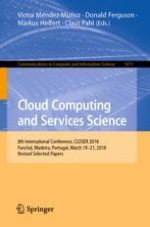2019 | Book
Cloud Computing and Services Science
8th International Conference, CLOSER 2018, Funchal, Madeira, Portugal, March 19-21, 2018, Revised Selected Papers
Editors: Víctor Méndez Muñoz, Donald Ferguson, Dr. Markus Helfert, Claus Pahl
Publisher: Springer International Publishing
Book Series : Communications in Computer and Information Science
